Introduction
Update (2024-03-05)
I am back on Twitter . I still think Elon is a terrible human being and he does not know jack shit about what he’s doing; however, Twitter is still the best way to represent the communities I represent, and spread the word around when needed. I have other reasons to be back, which I’ll try to expand in this sidenote a bit.
For starters, when you see everyone who despises Elon, still continue tweeting, it does not make logical sense to shield you away. I tried that for at least six months. For six freaking months, I was only at Mastodon, not even glancing at Twitter. But when I checked back, I realized every single person who was against Elon was still on the platform.
If we don’t move as a community, my individual resistance would have been futile, and even counterproductive. So, I’m still on the platform. Yes, twitter is a racist, sexist, misogynistic, hatred-fulled dumspster fire; however, no alternative platform has been strong enough to force it to extinction. For whatever reason, it’s still around.
The current Twitter (which Elon calls “X” because he is obsessed with the letter) is like a democracy ran by a tyrant. People are (still) there, because no matter how much it sucks, it is the only platform that helps them connect to the world at scale. When you run away, you isolate yourself.
Social isolation is the opposite of social media: Nobody wants that.
So, as long as there is no significant competitor to take its place, this hell hole of a birdsite will continue to exist. And I will be there being myself, not giving a flying clue to others.
After all the madness that has been happening in the birdsite, I flipped the switch, gave Elon the middle finger, and joined Mastodon (on Hachyderm, where all the misfits hang out).
With that, I have also wanted to create my own Mastodon instance for a while.
This article summarizes my experiences with the process and provides tips and tricks to those who wish to follow the same path.
This Article Applies to Mastodon v3.5.3
The article here discusses my deployment experience for v3.5.3 of Mastodon. If you are deploying a different version, make sure to follow the official installation guides.
I’ve recently upgraded to a much newer version, and the installation/upgrade experience was very smooth.
What Is a Mastodon Instance?
Interested? Check Out Fedi.Tips
For those new to the concept and want to learn more about Mastodon and the Fediverse, fedi.tips is a great reference.
To sum it up at a very high level, Fediverse is a collection of independently-run servers. You can create an account in any one of them and follow, like, comment, and otherwise interact with anyone else with thousands of other servers.
It’s like you have a passport tied to a single country. And with that passport, you can visit any country you like and interact with the people and culture there. So that’s where the “Fed” of the Fediverse comes from: It is “federated.”
Though, if you are at a point to deploy your own Mastodon instance, you probably already know that 😀.
Why Would You Want Your Own Instance?
So, why would anyone want to create their own Mastodon instance?
The first thing is, with your instance, you have total control over the content and the community. If you are a content creator or someone with relatively high visibility, it makes perfect sense to have your own Mastodon instance and interact with people who want the hear what you have to say there.
With this approach, you manage your identity instead of letting your identity become an advertising opportunity for a billion-dollar corporation.
Secondly, use it as a microblog, where you gather your thoughts and share one-off ideas. If they are not that interesting to others, who cares 🤷♂️? It’s your instance, server, ideas, and rules. I use my instance to write down random to-do notes, share bookmarks to things I might not easily find later, and so on. Even this article you read is based on a thread that I started at z2h.dev.
Or you can do it out of curiosity: To have fun exploring new technology, because you can 🙂. No matter your intention, if you want to create your instance, here is my recent experience.
z2h.dev is my Little Kingdom
As of now, I’m running a single-person instance. Like, it’s only me on the server, sharing my random stuff. Yet, it’s public; so people still come and go and occasionally like and boost the content too.
Having a single-person instance, my compute requirements are minimal. Keep in mind that as the number of users in your instance increase, so will your compute requirements.
Mastodon can be a beast to scale up, especially if your community is active, vibrant, and highly engaged. Which also is an excellent segue to the next section.
The Infra
Here's my current setup:
- A single dedicated Linode server with 2 CPU cores and 4 GB of Memory.
- Amazon S3 is the backing data store for static assets.
- Amazon CloudFront as a CDN layer in front of S3.
- AWS Certificate Manager to manage TLS certificates for the static assets (files.z2h.dev).
- Certbot to do the same for the content at z2h.dev.
- Linode DNS, to manage the DNS records on the Linode end.
- Linode Cloud Firewall because I want my box to be safe.
- Linode Backups because I don't want to worry about losing data.
- Mailgun as the SMTP server because using a local SMTP can be problematic, especially when/if I want to extend the server to a larger audience. You should follow Mailgun's official documentation for SMTP configuration.
Here's what my current server utilization looks like:
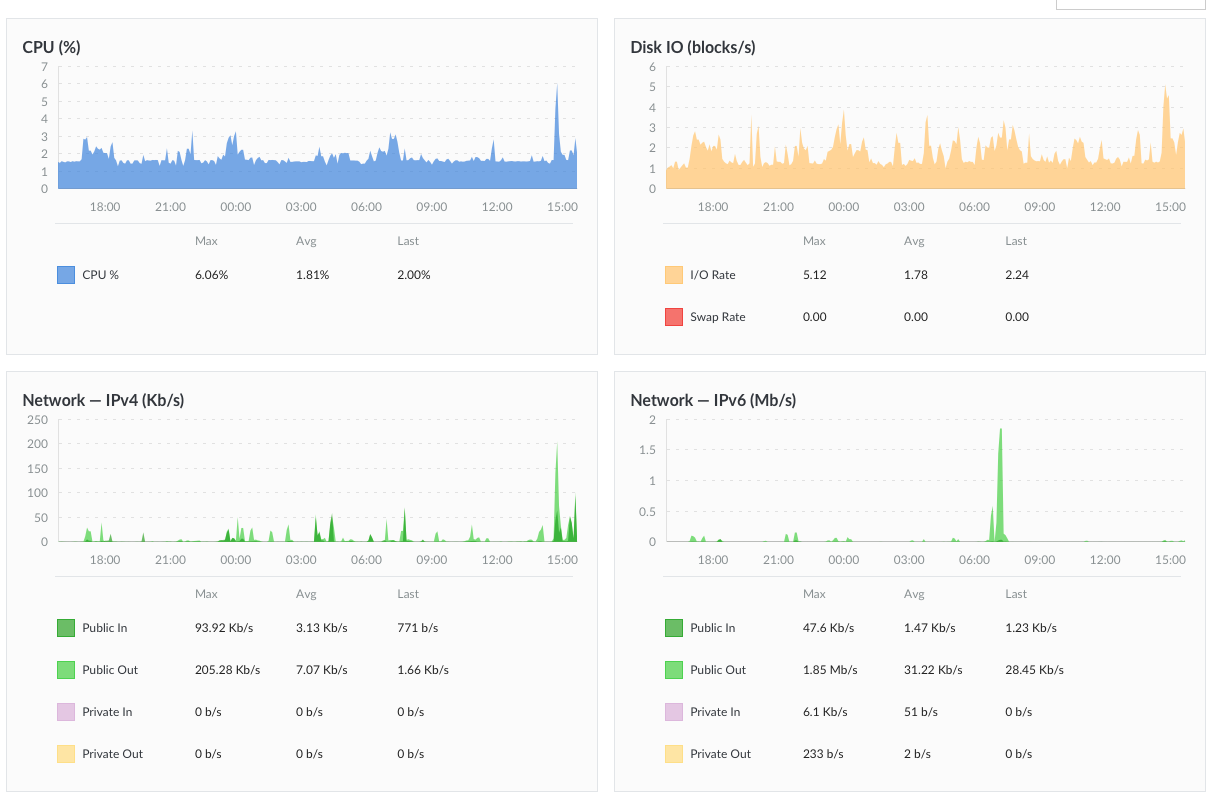
It’s not much because there is not much going on. Yet, it also shows that the above specs are more than adequate to run your own Mastodon instance.
Server Version
I’m running an Ubuntu server (which Mastodon official docs recommend, too) with the following version:
Distributor ID: Ubuntu
Description: Ubuntu 22.10
Release: 22.10
Codename: kinetic
Compute and Memory Requirements
Regarding resource utilization, I’m coasting at 1GB of ram and almost zero CPU (because only one person, me, is posting). So if you want to run a single-person instance, a VPS that gives you 2gigs of RAM and some minimal CPU would work for your needs.
Though, your compute, and memory requirements be much higher depending on the traffic and activity on your instance.
Securing The Machine
Since this is a Linode box, I’ve followed Linode’s security recommendations. I won’t detail them here because the way you secure your system will also depend on what you plan to use; however, you can follow the excellent documentation that Linode has on those topics:
- Setting Up and Securing a Compute Instance
- Using Fail2ban to Secure Your Server
- Set Up a Web Server and Host a Website
Firewall Rules
I don’t have that complicated of a firewall setup. Here is what it looks like:
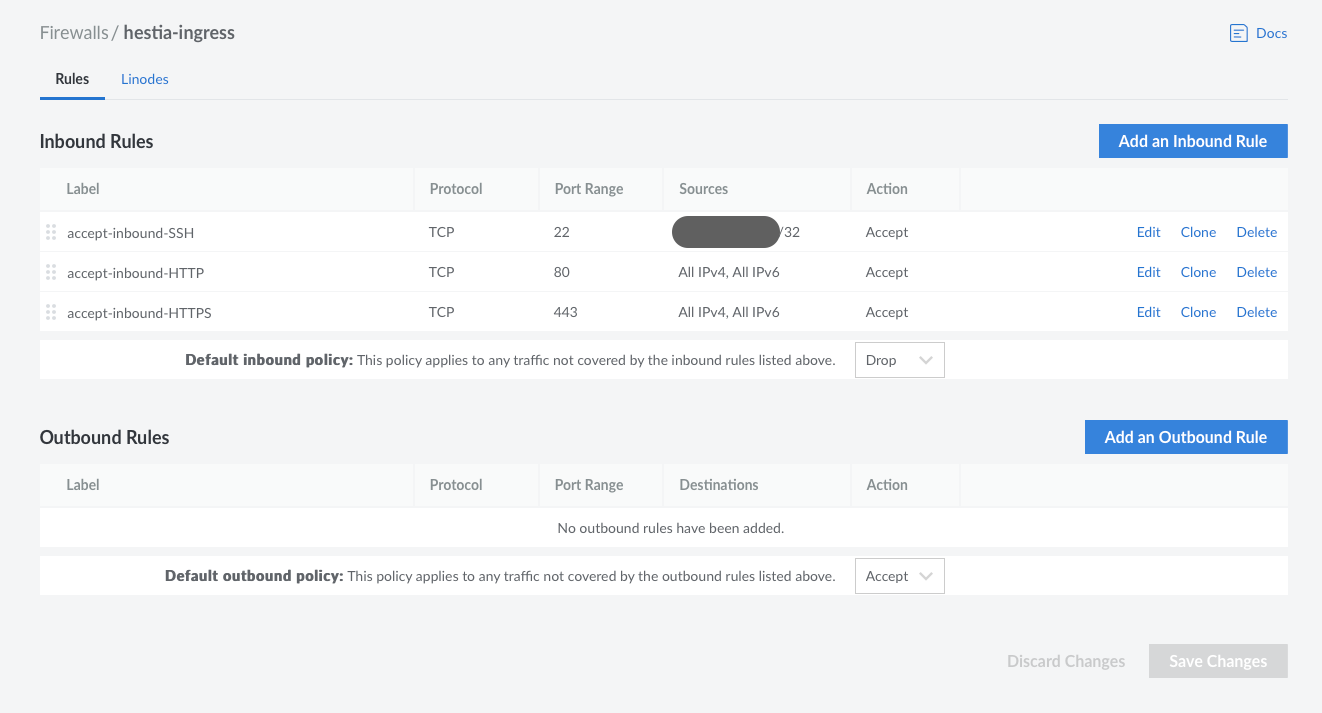
- Inbound
– Allow inbound ssh to a single IP– Accept all inbound HTTP– Accept all inbound HTTPS– Deny everything else - Outbound
– Allow everything
Which is good enough for the purpose of this application.
DNS Settings
For the sake of completeness, I’ll share the DNS settings too. Here’s what it looks like:
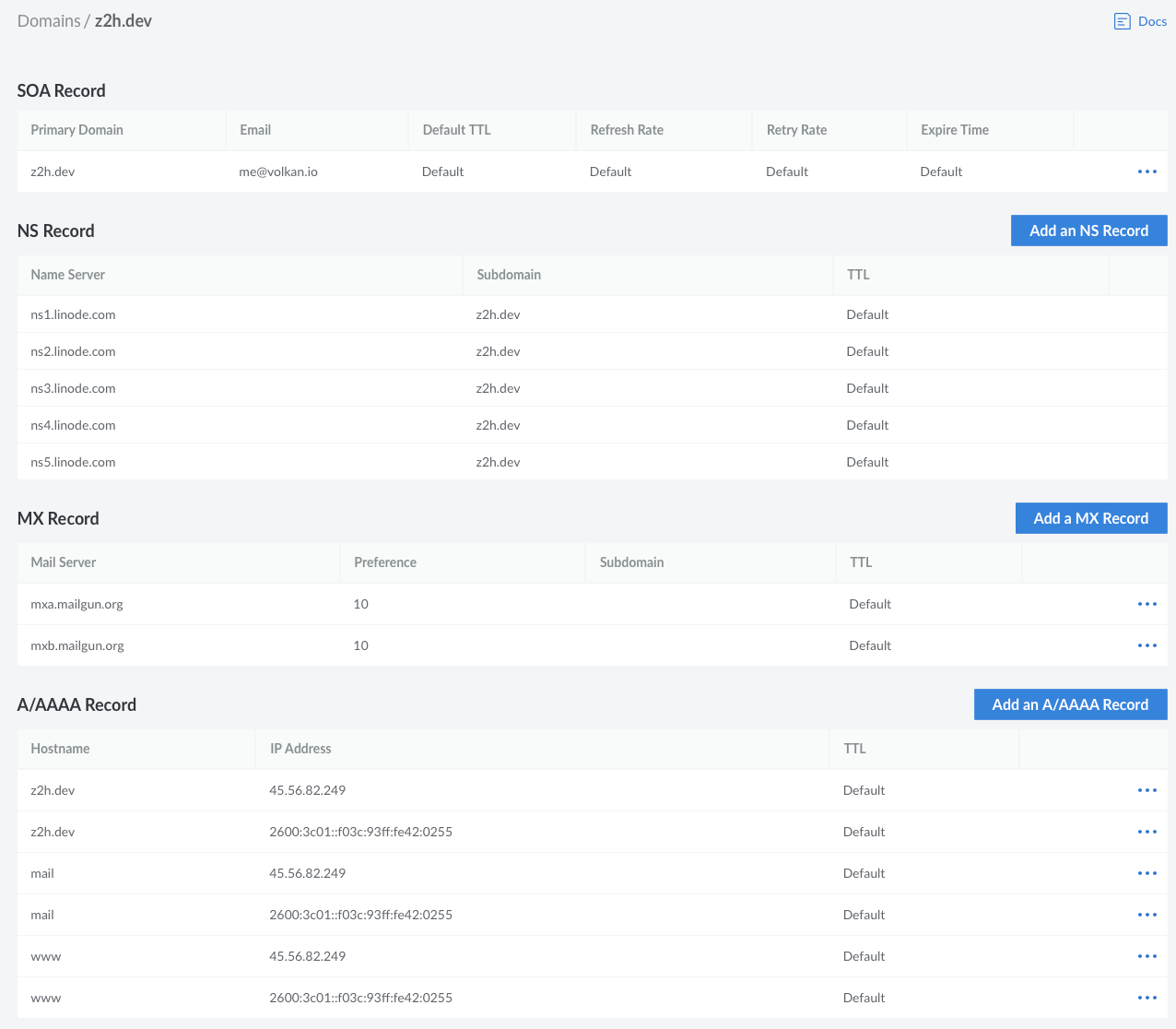
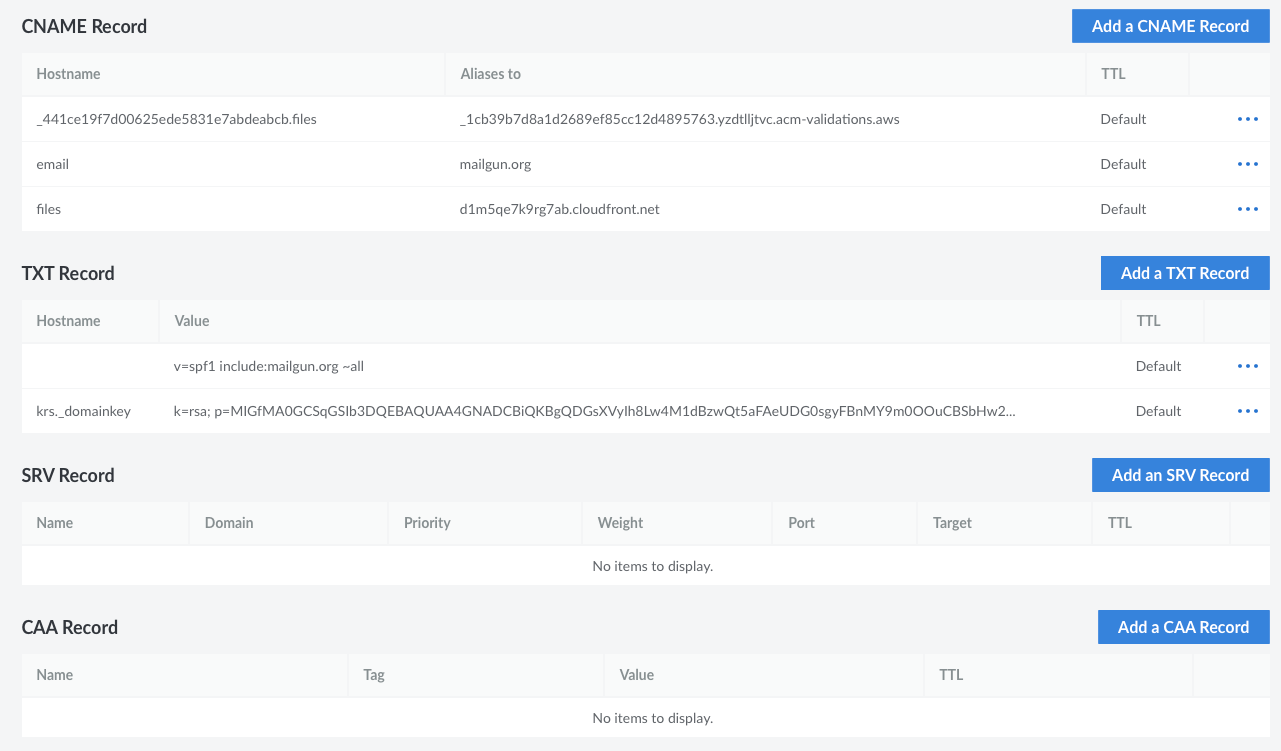
The CNAME records are there for Mailgun to be able to validate the domain; you can check its documentation for instructions about how to set it up.
Also, note that a CNAME record for files.z2h.dev points to an Amazon CloudFront CDN; we’ll come to that soon.
The TXT records are for Mailgun SPF Validation and for AWS Certificate Manager to issue and verify certificates to the static assets served at files.z2h.dev on an AWS S3 bucket.
CloudFront Setup
The thing about Mastodon is it will store files. Lots of files. Images, memes, animated gifs, videos… they need to go somewhere. And the local disk of your machine is not the best place to put them.
In my current setup, I’m using an S3 bucket backed up by CloudFront to sort that out.
Here are the CloudFront distribution settings for files.z2h.dev for reference:



S3 Bucket Settings
The CloudFront uses an S3 Bucket as its origin. Here are the details of the bucket.
I have set up a bucket policy to publicly allow GET operations on the bucket.
{
"Version": "2012-10-17",
"Statement": [
{
"Sid": "Allow Public Access to All Objects",
"Effect": "Allow",
"Principal": "*",
"Action": "s3:GetObject",
"Resource": "arn:aws:s3:::files.z2h.dev/*"
}
]
}
I also had to enable access control lists on the bucket for my Mastodon instance to push stuff to it without raising errors. So here’s how that part looks on the console:
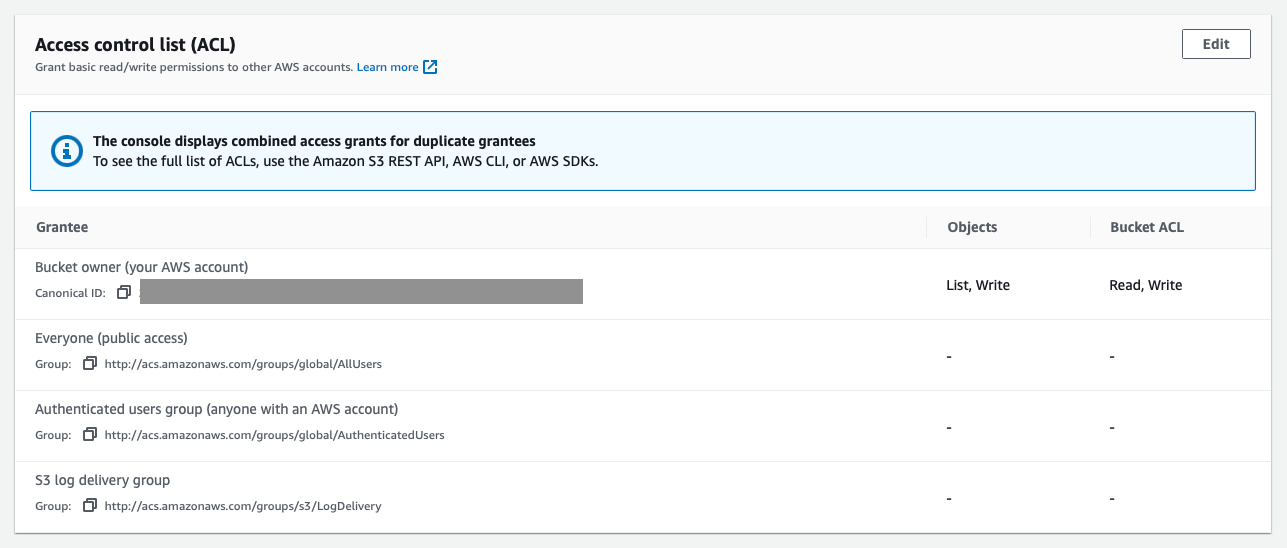
Without these ACL rules, Mastodon could not upload files to the bucket.
Other than that, everything on the bucket is in its default settings.
Setting Up Mastodon The Hard Way
Now, we come to the fun part. You can install Mastodon
- As a set of Docker containers (using docker-compose).
- As a Kubernetes deployment.
- Or as a bare-metal installation directly on your server.
I tried the Docker installation route but could not make it work. It might be because I was using an RC version instead of a stable one, or maybe because I missed a step during the installation; however, I had better luck with the bare-metal installation, so I’ll explain that in this article.
Besides, a bare-metal install will give you the best performance benefit compared to the alternatives.
So there are no helm templates, no Docker compose files… We’re gonna do this the hard way (Kelsey, anyone?)
You’ll Need An Older Version of yarn
One of the most significant issues you are likely going to face is if you follow the official docs. As of the time of this writing (late 2022), the docs’ instruction on installing node and yarn is inadequate and incomplete, and if you follow them step-by-step, you’ll likely fail while bundling the static assets.
The gist is:
- You need an older version of
yarn(v1.x) to bundle static assets. - However, you need the most recent
nodeversion for security and stability.
I was able to do that by…
- Installing the recent versions of
nodeand yarn on the system, - And then patching the
yarnbinaries with the most recent v1.x release that I could find.
The following sections outline how I managed to do that.
Install node and npm
First, install the recent version of node and npm:
sudo apt install curl wget gnupg apt-transport-https \
lsb-release ca-certificates
# Install node.
# You can also try a newer version of Node.
# I’m using v18.x as of now.
curl -sL https://deb.nodesource.com/setup_18.x | bash -
# Check node and npm versions.
node -v
# v18.7.0
npm -v
# 6.14.17
You Might Want to Usenvm
Note that you might want to usenvm(Node Version Manager)
to switch between different versions ofnode.
That might be helpful if your Mastodon instance does not function
properly using a particular version ofnode.
Create an Unprivileged mastodon User
The next thing is to create a dedicated user to run Mastodon. This is recommended because Mastodon is a ruby monolith, and switching to different user accounts is a hassle-free way to experiment with different Ruby versions.
Besides, having a dedicated, unprivileged user is a good security practice.
# Add a `mastodon` user, if you haven’t already done so
adduser --disabled-login mastodon
# Set a password for the user:
sudo passwd mastodon
# Switch to that user:
sudo su - mastodon
# Validate that we are on the correct user accout:
whoami
# mastodon
Configure npm to Work Without Root Privileges
Next, we’ll configure npm to work rootless because we are not allowed to do sudo for the mastodon user.
sudo su - mastodon
mkdir ~/.npm-global
npm config set prefix '~/.npm-global'
# Update ~/.profile with this:
# export PATH=~/.npm-global/bin:$PATH
# Then source it to use the new $PATH:
source ~/.profile
Patch yarn
This is the critical part. You’ll need to use the v1.x version of yarn (at least when this article is written, that’s the case). If you install yarn following the documentation, you’ll get a much higher version, which will cause errors when bundling static asses for the web application.
sudo su - mastodon
wget https://github.com/yarnpkg/yarn/releases/\
download/v1.22.19/yarn-v1.22.19.tar.gz
tar -xzvf yarn-v1.22.19.tar.gz
cd yarn-v1.22.19/
cd bin/
cp yarn /home/mastodon/.npm-global/bin/
cp yarnpkg /home/mastodon/.npm-global/bin/
cd ..
cp bin/* /home/mastodon/.npm-global/bin
That will hopefully take care of your possible yarn problems. If not, you can find yourself experimenting with things a bit. Honestly, this version incompatibility was the most challenging part. That took hours for me to fix. I’m sharing it here so that others don’t suffer the same pains I’ve had.
Install Postgres
Mastodon uses Postgres (or any Postgres-compatible DB) as its backend database. So, we’ll install that to our instance too.
sudo su
wget -O /usr/share/keyrings/postgresql.asc \
https://www.postgresql.org/media/keys/ACCC4CF8.asc
echo "deb [signed-by=/usr/share/keyrings/postgresql.asc] \
http://apt.postgresql.org/pub/repos/apt \
$(lsb_release -cs)-pgdg main" \
> /etc/apt/sources.list.d/postgresql.list
apt update
apt install -y \
imagemagick ffmpeg libpq-dev libxml2-dev libxslt1-dev \
file git-core g++ libprotobuf-dev protobuf-compiler \
pkg-config nodejs gcc autoconf \
bison build-essential libssl-dev libyaml-dev libreadline6-dev \
zlib1g-dev libncurses5-dev libffi-dev libgdbm-dev \
nginx redis-server redis-tools postgresql postgresql-contrib \
certbot python3-certbot-nginx libidn11-dev libicu-dev \
libjemalloc-devInstall Ruby
Mastodon is a Ruby server, so we’ll, for sure, need ruby.
su - mastodon
git clone https://github.com/rbenv/rbenv.git ~/.rbenv
cd ~/.rbenv && src/configure && make -C src
echo 'export PATH="$HOME/.rbenv/bin:$PATH"' >> ~/.bashrc
echo 'eval "$(rbenv init -)"' >> ~/.bashrc
exec bash
git clone https://github.com/rbenv/ruby-build.git \
~/.rbenv/plugins/ruby-build
Once that’s done, install the ruby version that we need:
RUBY_CONFIGURE_OPTS=--with-jemalloc rbenv install 3.0.3
rbenv global 3.0.3
We’ll also need bundler:
gem install bundler --no-document
Configure Postgres
Next up, we’ll configure our database:
sudo -u postgres psql
CREATE USER mastodon CREATEDB;
\q
And, that’s it 🙌.
Set Up Mastodon
Now it’s time to set up the elephant in the room.
We’ll build Mastodon straight from the source code.
git clone https://github.com/tootsuite/mastodon.git \
live && cd live
git checkout \
$(git tag -l | grep -v 'rc[0-9]*$' | sort -V | tail -n 1)
bundle config deployment 'true'
bundle config without 'development test'
bundle install -j$(getconf _NPROCESSORS_ONLN)
yarn install --pure-lockfile
After all these set, we’ll run the interactive setup wizard:
RAILS_ENV=production bundle exec rake mastodon:setup
The wizard will ask you certain questions. I’ve added my answers to some of those, redacting sensitive parts.
LOCAL_DOMAIN=z2h.dev
SINGLE_USER_MODE=false
DB_HOST=/var/run/postgresql
DB_PORT=5432
DB_NAME=mastodon_production
DB_USER=mastodon
DB_PASS=
REDIS_HOST=localhost
REDIS_PORT=6379
REDIS_PASSWORD=
S3_ENABLED=true
S3_PROTOCOL=https
S3_BUCKET=files.z2h.dev
S3_REGION=us-west-2
S3_HOSTNAME=s3.us-west-2.amazonaws.com
AWS_ACCESS_KEY_ID=AKIA[REDACTED]
AWS_SECRET_ACCESS_KEY=Yj[REDACTED]
S3_ALIAS_HOST=files.z2h.dev
SMTP_SERVER=smtp.mailgun.org
SMTP_PORT=587
SMTP_LOGIN=postmaster@z2h.dev
SMTP_PASSWORD=b[REDACTED]
SMTP_AUTH_METHOD=plain
SMTP_OPENSSL_VERIFY_MODE=none
SMTP_FROM_ADDRESS='Mastodon <notifications@z2h.dev>'
Once the installer finishes successfully, you’ll get a prompt similar to this:
All done! You can now power on the Mastodon server 🐘
Do you want to create an admin user straight away? Yes
Username: $usernameYouChoseDuringSetup
E-mail: $emailYouChoseDuringSetup
You can login with the password: $someRandomPassword
You can change your password once you login.
The Installer Gave Me anemoji-mart-Related Error
Before triggering the setup, I also had to manuallynpm install --save emoji-martin thelivefolder
because the installer complained otherwise.
I don’t know if it will be fixed by the time you use the latest and
greatest Mastodon. Yet, I wanted to share it here in case you
bump into a similar issue.
Getting TLS Certificates
Once you have your compute instance, DNS, and ingress firewall set up, you can fetch a TLS certificate from Let’s Encrypt using certbot:
sudo certbot certonly --standalone -d z2h.dev
The command above will temporarily spin up a web server, do the necessary negotiations and fetch a TLS certificate for the domain z2h.dev.
Also, ensure that certbot timer is enabled via systemctl status certbot.timer. If the timer is not enabled, make sure to enable it using systemctl enable certbot.timer.
volkan@z2h-dev:~$ systemctl status certbot.timer
● certbot.timer - Run certbot twice daily
Loaded: loaded (/lib/systemd/system/certbot.timer;
enabled; preset: enabled)
Active: active (waiting)
since Fri 2022-11-11 03:02:18 PST; 1 day 9h ago
Until: Fri 2022-11-11 03:02:18 PST; 1 day 9h ago
Trigger: Sat 2022-11-12 22:37:01 PST; 10h left
Triggers: ● certbot.service
Also, make sure that your certificates are where they need to be:
sudo ls -al /etc/letsencrypt/live/z2h.dev
# The output should look something like this:
# drwxr-xr-x 2 root root 4096 Nov 11 02:41 .
# drwx------ 3 root root 4096 Nov 11 02:41 ..
# lrwxrwxrwx 1 root root 31 Nov 11 02:41 cert.pem
# -> ../../archive/z2h.dev/cert1.pem
# lrwxrwxrwx 1 root root 32 Nov 11 02:41 chain.pem
# -> ../../archive/z2h.dev/chain1.pem
# lrwxrwxrwx 1 root root 36 Nov 11 02:41
# fullchain.pem -> ../../archive/z2h.dev/fullchain1.pem
# lrwxrwxrwx 1 root root 34 Nov 11 02:41 privkey.pem
# -> ../../archive/z2h.dev/privkey1.pem
# -rw-r--r-- 1 root root 692 Nov 11 02:41 README
Configure NGINX
Now that we have our certificates in place, we can configure NGINX.
Here’s my /etc/nginx/sites-available/z2h.dev.conf
map $http_upgrade $connection_upgrade {
default upgrade;
'' close;
}
upstream backend {
server 127.0.0.1:3000 fail_timeout=0;
}
upstream streaming {
server 127.0.0.1:4000 fail_timeout=0;
}
proxy_cache_path /var/cache/nginx levels=1:2
keys_zone=CACHE:10m inactive=7d max_size=1g;
server {
listen 80;
listen [::]:80;
server_name z2h.dev;
root /home/mastodon/live/public;
location /.well-known/acme-challenge/ { allow all; }
location / { return 301 https://$host$request_uri; }
}
server {
listen 443 ssl http2;
listen [::]:443 ssl http2;
server_name z2h.dev;
ssl_protocols TLSv1.2 TLSv1.3;
ssl_ciphers HIGH:!MEDIUM:!LOW:!aNULL:!NULL:!SHA;
ssl_prefer_server_ciphers on;
ssl_session_cache shared:SSL:10m;
ssl_session_tickets off;
# Uncomment these lines once you acquire a certificate:
ssl_certificate /etc/letsencrypt/live/z2h.dev/fullchain.pem;
ssl_certificate_key /etc/letsencrypt/live/z2h.dev/privkey.pem;
keepalive_timeout 70;
sendfile on;
client_max_body_size 80m;
root /home/mastodon/live/public;
gzip on;
gzip_disable "msie6";
gzip_vary on;
gzip_proxied any;
gzip_comp_level 6;
gzip_buffers 16 8k;
gzip_http_version 1.1;
gzip_types text/plain text/css application/json
application/javascript text/xml application/xml
application/xml+rss text/javascript
image/svg+xml image/x-icon;
location / {
try_files $uri @proxy;
}
location = /sw.js {
add_header Cache-Control
"public, max-age=604800, must-revalidate";
add_header Strict-Transport-Security
"max-age=63072000; includeSubDomains";
try_files $uri =404;
}
location ~ ^/assets/ {
add_header Cache-Control
"public, max-age=2419200, must-revalidate";
add_header Strict-Transport-Security
"max-age=63072000; includeSubDomains";
try_files $uri =404;
}
location ~ ^/avatars/ {
add_header Cache-Control
"public, max-age=2419200, must-revalidate";
add_header Strict-Transport-Security
"max-age=63072000; includeSubDomains";
try_files $uri =404;
}
location ~ ^/emoji/ {
add_header Cache-Control
"public, max-age=2419200, must-revalidate";
add_header Strict-Transport-Security
"max-age=63072000; includeSubDomains";
try_files $uri =404;
}
location ~ ^/headers/ {
add_header Cache-Control
"public, max-age=2419200, must-revalidate";
add_header Strict-Transport-Security
"max-age=63072000; includeSubDomains";
try_files $uri =404;
}
location ~ ^/packs/ {
add_header Cache-Control
"public, max-age=2419200, must-revalidate";
add_header Strict-Transport-Security
"max-age=63072000; includeSubDomains";
try_files $uri =404;
}
location ~ ^/shortcuts/ {
add_header Cache-Control
"public, max-age=2419200, must-revalidate";
add_header Strict-Transport-Security
"max-age=63072000; includeSubDomains";
try_files $uri =404;
}
location ~ ^/sounds/ {
add_header Cache-Control
"public, max-age=2419200, must-revalidate";
add_header Strict-Transport-Security
"max-age=63072000; includeSubDomains";
try_files $uri =404;
}
location ~ ^/system/ {
add_header Cache-Control
"public, max-age=2419200, immutable";
add_header Strict-Transport-Security
"max-age=63072000; includeSubDomains";
try_files $uri =404;
}
location ^~ /api/v1/streaming {
proxy_set_header Host $host;
proxy_set_header X-Real-IP $remote_addr;
proxy_set_header X-Forwarded-For $proxy_add_x_forwarded_for;
proxy_set_header X-Forwarded-Proto $scheme;
proxy_set_header Proxy "";
proxy_pass http://streaming;
proxy_buffering off;
proxy_redirect off;
proxy_http_version 1.1;
proxy_set_header Upgrade $http_upgrade;
proxy_set_header Connection $connection_upgrade;
add_header Strict-Transport-Security
"max-age=63072000; includeSubDomains";
tcp_nodelay on;
}
location @proxy {
proxy_set_header Host $host;
proxy_set_header X-Real-IP $remote_addr;
proxy_set_header X-Forwarded-For $proxy_add_x_forwarded_for;
proxy_set_header X-Forwarded-Proto $scheme;
proxy_set_header Proxy "";
proxy_pass_header Server;
proxy_pass http://backend;
proxy_buffering on;
proxy_redirect off;
proxy_http_version 1.1;
proxy_set_header Upgrade $http_upgrade;
proxy_set_header Connection $connection_upgrade;
proxy_cache CACHE;
proxy_cache_valid 200 7d;
proxy_cache_valid 410 24h;
proxy_cache_use_stale error timeout
updating http_500 http_502 http_503 http_504;
add_header X-Cached $upstream_cache_status;
tcp_nodelay on;
}
error_page 404 500 501 502 503 504 /500.html;
}
I’ve copied the file from Mastodon’s source code repo and changed example.com to z2h.dev in the file.
Set Up NGINX to Use mastodon User
One more thing, nginx, by default, uses www-data as a user, and that—in my case—caused issues when I started Mastodon’s microservices. Editing /etc/nginx/nginx.conf and replacing www-data with mastodon fixed that for me.
Here’s the entire file for reference:
user mastodon;
#user www-data;
worker_processes auto;
pid /run/nginx.pid;
include /etc/nginx/modules-enabled/*.conf;
events {
worker_connections 768;
}
http {
sendfile on;
tcp_nopush on;
types_hash_max_size 2048;
include /etc/nginx/mime.types;
default_type application/octet-stream;
ssl_protocols TLSv1 TLSv1.1 TLSv1.2 TLSv1.3;
ssl_prefer_server_ciphers on;
access_log /var/log/nginx/access.log;
error_log /var/log/nginx/error.log;
gzip on;
include /etc/nginx/conf.d/*.conf;
include /etc/nginx/sites-enabled/*;
}
Link the Site
cd /etc/nginx/sites-enabled
sudo ln -s ../sites-available/z2h.dev.conf
This will make NGINX import and use the rules that we’ve defined in the former section.
Start NGINX
Then we can start nginx:
sudo systemctl restart nginx
Then check the status of the nginx service:
volkan@z2h-dev:~$ sudo systemctl status nginx
● nginx.service -
A high performance web server and a reverse proxy server
Loaded: loaded
(/lib/systemd/system/nginx.service; enabled; preset: enabled)
Active: active (running)
So far, all looking good 👌.
Setting Up systemd Services
Make sure you have these files under /etc/systemd/system. Again, I’ve copied them from the official Mastodon repository.
/etc/systemd/system/mastodon-sideqik.service
[Unit]
Description=mastodon-sidekiq
After=network.target
[Service]
Type=simple
User=mastodon
WorkingDirectory=/home/mastodon/live
Environment="RAILS_ENV=production"
Environment="DB_POOL=25"
Environment="MALLOC_ARENA_MAX=2"
Environment="LD_PRELOAD=libjemalloc.so"
ExecStart=/home/mastodon/.rbenv/shims/bundle exec sidekiq -c 25
TimeoutSec=15
Restart=always
# Proc filesystem
ProcSubset=pid
ProtectProc=invisible
# Capabilities
CapabilityBoundingSet=
# Security
NoNewPrivileges=true
# Sandboxing
ProtectSystem=strict
PrivateTmp=true
PrivateDevices=true
PrivateUsers=true
ProtectHostname=true
ProtectKernelLogs=true
ProtectKernelModules=true
ProtectKernelTunables=true
ProtectControlGroups=true
RestrictAddressFamilies=AF_INET
RestrictAddressFamilies=AF_INET6
RestrictAddressFamilies=AF_NETLINK
RestrictAddressFamilies=AF_UNIX
RestrictNamespaces=true
LockPersonality=true
RestrictRealtime=true
RestrictSUIDSGID=true
RemoveIPC=true
PrivateMounts=true
ProtectClock=true
# System Call Filtering
SystemCallArchitectures=native
SystemCallFilter=~@cpu-emulation @debug
@keyring @ipc @mount @obsolete @privileged @setuid
SystemCallFilter=@chown
SystemCallFilter=pipe
SystemCallFilter=pipe2
ReadWritePaths=/home/mastodon/live
[Install]
WantedBy=multi-user.target
/etc/systemd/system/mastodon-streaming.service
[Unit]
Description=mastodon-streaming
After=network.target
[Service]
Type=simple
User=mastodon
WorkingDirectory=/home/mastodon/live
Environment="NODE_ENV=production"
Environment="PORT=4000"
Environment="STREAMING_CLUSTER_NUM=1"
ExecStart=/usr/bin/node ./streaming
TimeoutSec=15
Restart=always
# Proc filesystem
ProcSubset=pid
ProtectProc=invisible
# Capabilities
CapabilityBoundingSet=
# Security
NoNewPrivileges=true
# Sandboxing
ProtectSystem=strict
PrivateTmp=true
PrivateDevices=true
PrivateUsers=true
ProtectHostname=true
ProtectKernelLogs=true
ProtectKernelModules=true
ProtectKernelTunables=true
ProtectControlGroups=true
RestrictAddressFamilies=AF_INET
RestrictAddressFamilies=AF_INET6
RestrictAddressFamilies=AF_NETLINK
RestrictAddressFamilies=AF_UNIX
RestrictNamespaces=true
LockPersonality=true
RestrictRealtime=true
RestrictSUIDSGID=true
RemoveIPC=true
PrivateMounts=true
ProtectClock=true
# System Call Filtering
SystemCallArchitectures=native
SystemCallFilter=~@cpu-emulation @debug
@keyring @ipc @memlock @mount @obsolete
@privileged @resources @setuid
SystemCallFilter=pipe
SystemCallFilter=pipe2
ReadWritePaths=/home/mastodon/live
[Install]
WantedBy=multi-user.target
/etc/systemd/system/mastodon-web.service
[Unit]
Description=mastodon-web
After=network.target
[Service]
Type=simple
User=mastodon
WorkingDirectory=/home/mastodon/live
Environment="RAILS_ENV=production"
Environment="PORT=3000"
Environment="LD_PRELOAD=libjemalloc.so"
ExecStart=/home/mastodon/.rbenv/shims/bundle exec \
puma -C config/puma.rb
ExecReload=/bin/kill -SIGUSR1 $MAINPID
TimeoutSec=15
Restart=always
# Proc filesystem
ProcSubset=pid
ProtectProc=invisible
# Capabilities
CapabilityBoundingSet=
# Security
NoNewPrivileges=true
# Sandboxing
ProtectSystem=strict
PrivateTmp=true
PrivateDevices=true
PrivateUsers=true
ProtectHostname=true
ProtectKernelLogs=true
ProtectKernelModules=true
ProtectKernelTunables=true
ProtectControlGroups=true
RestrictAddressFamilies=AF_INET
RestrictAddressFamilies=AF_INET6
RestrictAddressFamilies=AF_NETLINK
RestrictAddressFamilies=AF_UNIX
RestrictNamespaces=true
LockPersonality=true
RestrictRealtime=true
RestrictSUIDSGID=true
RemoveIPC=true
PrivateMounts=true
ProtectClock=true
# System Call Filtering
SystemCallArchitectures=native
SystemCallFilter=~@cpu-emulation @debug
@keyring @ipc @mount @obsolete @privileged @setuid
SystemCallFilter=@chown
SystemCallFilter=pipe
SystemCallFilter=pipe2
ReadWritePaths=/home/mastodon/live
[Install]
WantedBy=multi-user.target
That handles the systemd part of things.
Checking The Services
Make sure you have all the services are up
sudo systemctl status mastodon-*
If any of the services are down or disabled, you can enable them:
sudo systemctl enable mastodon-web
sudo systemctl enable mastodon-sideqik
sudo systemctl enable mastodon-streaming
sudo systemctl start mastodon-web
sudo systemctl start mastodon-sideqik
sudo systemctl start mastodon-streaming
If you didn’t have any issues so far, you should have a running Mastodon instance that you can browse to the domain you set up (in my case it’s z2h.dev). Then, you can log in as an Administrator with a random password that the installer has provided you during the guided installation section you’ve followed above.
Securing Mastodon
Since we have Mastodon itself up and running, it’s time to secure the instance.
We’ll start with the users.
Ah, as soon as I created the instance, I made a second unprivileged user.
I use the root user only to administer the Mastodon server, and I use the unprivileged user z2h.dev/@volkan to post things on the site.
The next thing you MUST do is to enable 2FA for all users you control. DO NOT defer this. Mastodon is getting quite popular, which also means it’s attracting many people with bad intentions. Due to a zero-day vulnerability, you would not want your server to become a spammers’ barbeque backyard. 2FA is an added layer of security that makes it extra hard for attackers to impersonate you.
Scaling Up Mastodon
All the services Mastodon relies upon (i.e., Redis, Postgres, etc.) can scale independently. Mastodon is, in itself, stateless. That means you can put several Mastodon servers behind a load balancer and point them to the same Postgres and Redis, which will take care of scalability for a long time.
Here’s a high-level outline of how that might look like:
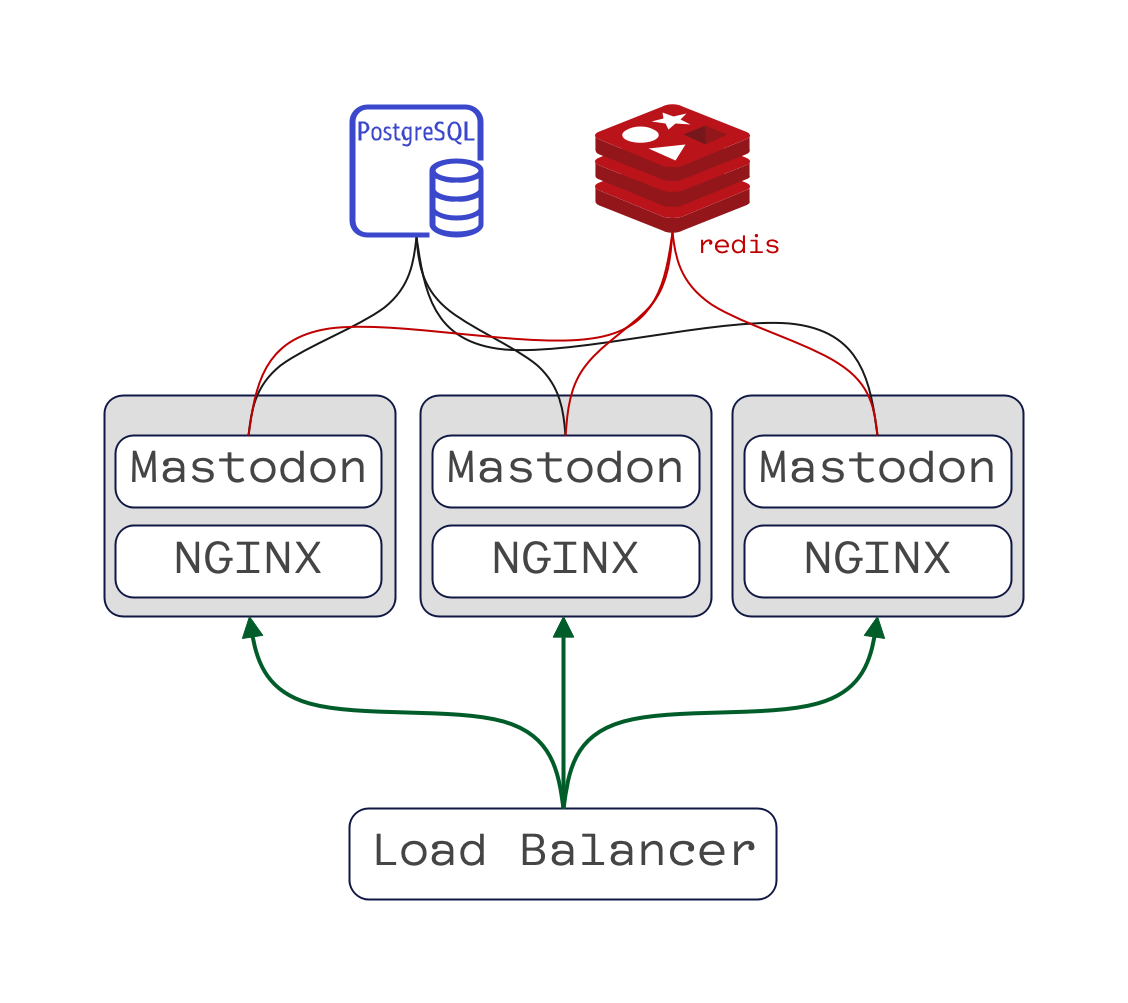
If things get even crazier, you’ll have to come up with solutions to the bottleneck you are facing. Like tuning Redis, adding read replicas; doing the same to Postgres; tuning NGINX, maybe backing NGINX with another cloud load balancer; sharding the data, geographically sharding the users… the list can go on.
However, if you have reached that scale, the thing has become your full-time job, and you probably have a team of intelligent engineers to sort out these problems with you 🙂. If not, then you don’t have to worry about future issues.
Monitoring and Operating Mastodon
SideKiq is the Ruby-based job queue that Mastodon uses. If you log into the admin panel, you can find a link to monitor its state.
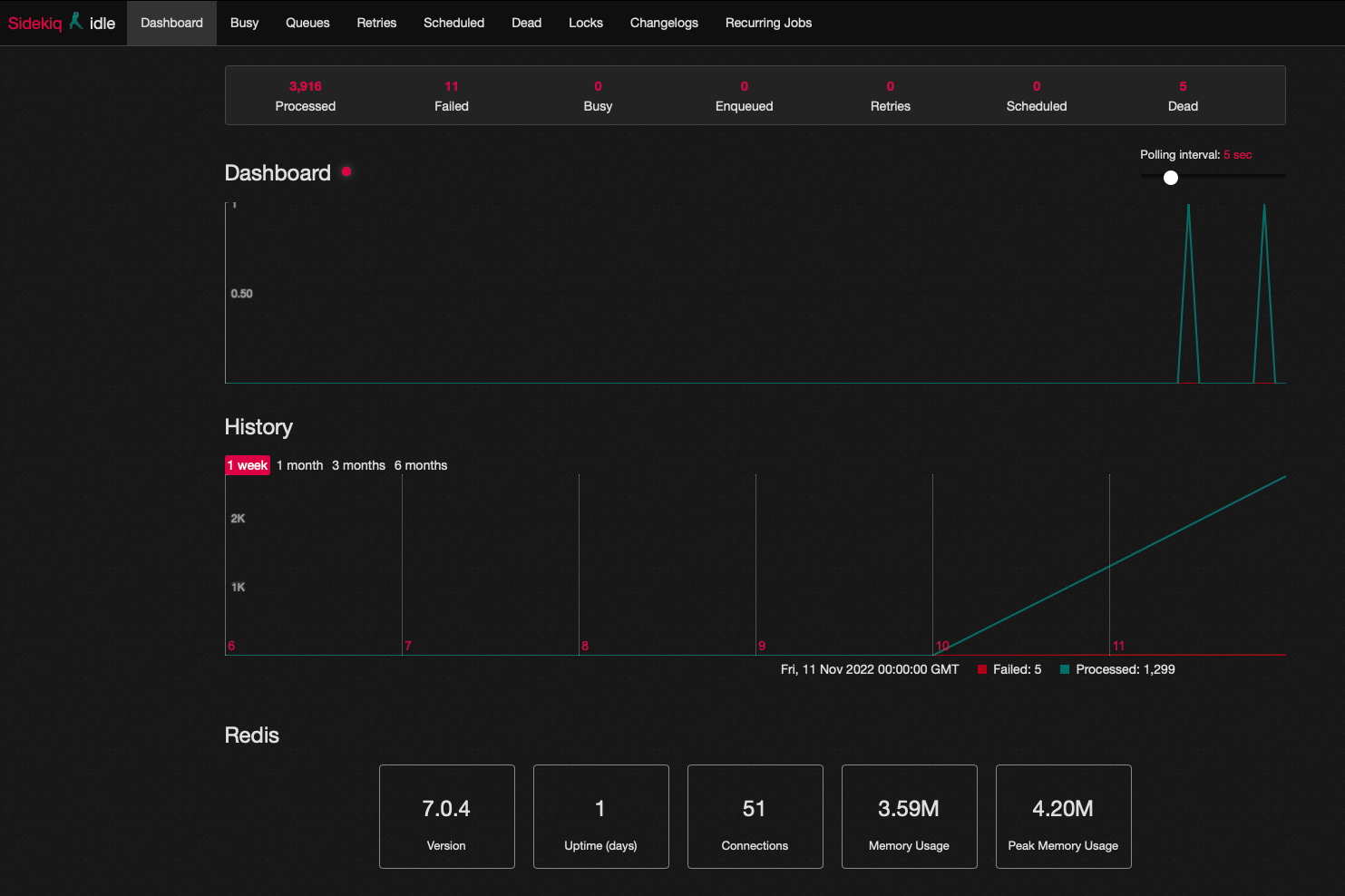
The Sidekiq dashboard is the first place you want to look when you feel things are slowing down.
In addition, you can find on the admin console PgHero that can show you important stats about your database.
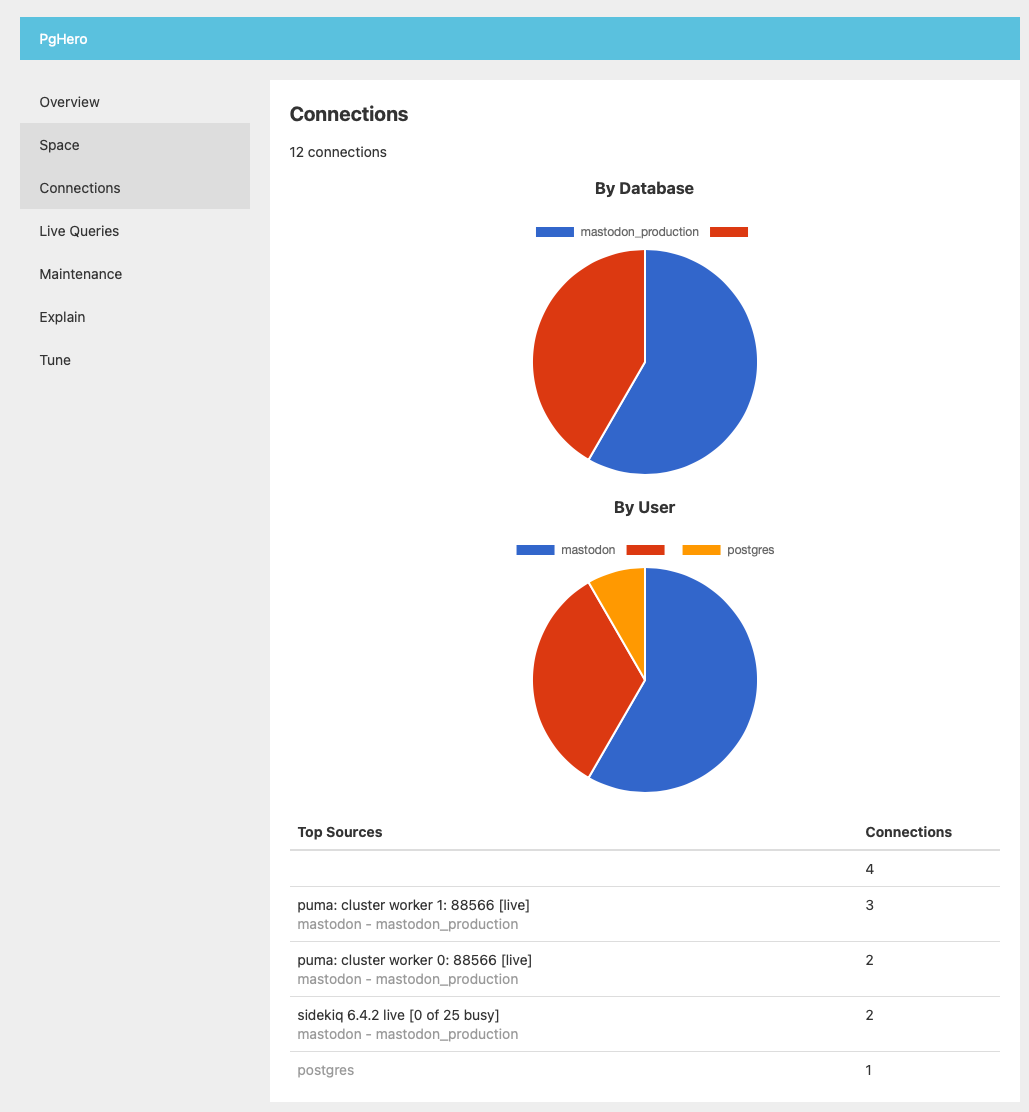
Also there is PgTune, which can help you tune optimize your database when you fill in some values in a web form.
Mastodon official documentation recommends you check out PgTune if you want to fine-tune your database further. That could be a low-hanging scalability fruit to use from day zero.
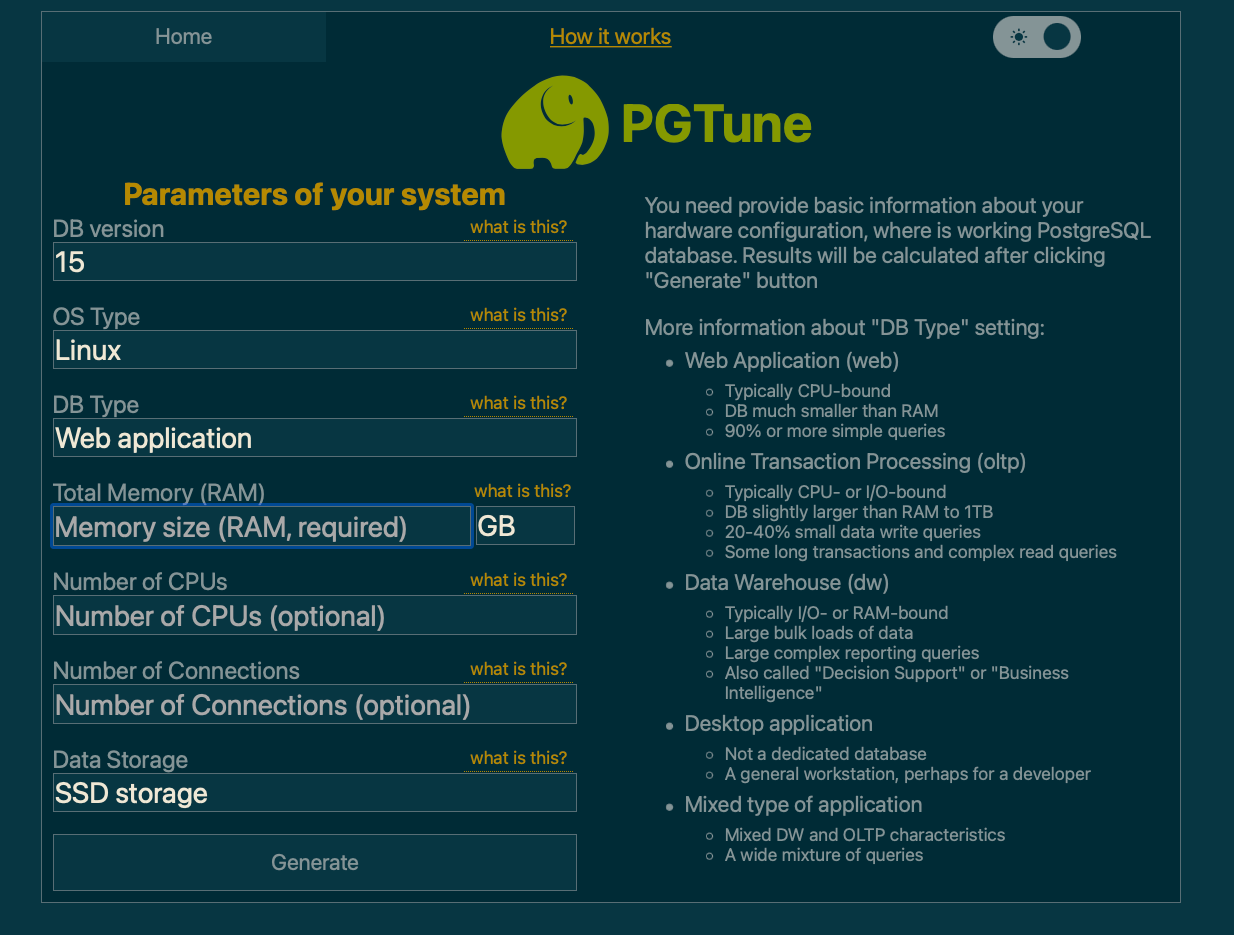
How you monitor Mastodon will vastly depend on where you run it. You might use your cloud provider’s altering mechanism, install an ELK Stack to take things under your control, or do a mixture of both and some more. I’ll keep that part out of the scope of this article.
Also, the official documentation is the right place to begin your search for anything related to fixing, operating, and configuring Mastodon.
Conclusion
That’s so far my experience and notes while installing Mastodon.
It took work, and I found myself debugging, looking into error messages, and checking out journalctl errors and NGINX access and error log more than I used to do in other guided installations.
However, it was not the most challenging thing either. The the official documentation is in good shape, and when things don’t work, the error messages make sense and help you figure out the next steps.
So, if you end up having a similar experience to mine, you’ll just need some patience and to tap into your analytical debugging skills a bit more than usual. Which also has been a fun learning experience that led to this article.
Hope you find it informative… And may the source be with you 🦄.


